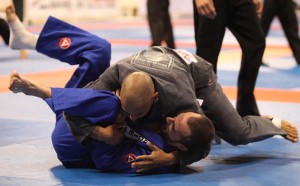My thoughts on how training jiu-jitsu gives you a realistic sense of self
5 Ways To Take 1st Place at Your Next Brazilian Jiu-Jitsu Tournament
5 Ways to Take 1st Place at Your Next Brazilian Jiu-Jitsu Tournament by Jamey Bazes
Jamey is a life-long martial artist, winner of over 100 competitive matches, and BJJ Brown Belt under Brian McLaughlin.
One of the great things about the sports of Brazilian Jiu-Jitsu and Submission grappling is that since there are a number of ways to score points and a number of legal submissions that can lead to a win it is possible to have many different game plans when competing. While some divisions are fought with the Gi on while others are strictly no-gi, and the point systems and legal techniques can vary from one tournament to the next, in general the same types of dominant positions and takedowns are likely to score points regardless and the majority of submissions are legal across the board. In this article I will discuss 5 different strategies which a grappler can use in grappling and BJJ tournaments to secure victories and take 1st place while citing experiences from some of my past tournament victories and what worked for me.
To add a little bit of personal background, I earned my Brazilian Jiu-Jitsu Brown Belt from Brian McLaughlin of Precision MMA back in 2010, though my actual Jiu-Jitsu journey began back in 1996 with Steve Kardian at Thornwood BJJ. Over the years my grappling style has changed quite a bit but I have certainly been exposed to multiple styles, from more traditional Gi grappling to explosive no-gi submission grappling techniques, wrestling based grappling, 10th Planet BJJ guard tactics, and even a very little bit of Judo and Sambo. After having competed in 33 tournaments under different rules at every belt from White to Brown, every experience level in no-gi and multiple weight classes I have seen first hand which strategies work and do not work in multiple scenarios, not only for myself but for my fellow competitors. As such, I would like to share 5 different formulas I have used and seen others use to successfully medal in different tournaments with the hopes that these can help future competitors to build game plans towards success when it comes time for them to compete.
Tournament strategy number 1: Top Control
No matter what rules one is competing under and whether the division is gi or no-gi, the importance of gaining and maintaining a dominant top position cannot be over emphasized. Though tournament rules and point systems will vary, in general points are scored for either a takedown or a sweep from bottom guard or half guard which results in one achieving a top position. If the competing grappler does score one of these, the worst case scenario is that he will end up on top in his opponent’s guard, and unless his opponent pulled guard to begin with this then that means that the grappler on top will probably start the match up on points. However, unlike wrestling, neither Gi Jiu-Jitsu or no-gi submission grappling matches end once a top position is achieved and some grapplers would prefer to play from bottom guard. With this in mind, it is essential that any top game player have extremely good submission defense and guard passing skills.
As most grapplers know, in the average tournament points will be achieved from passing guard to sidemount, and then more points from progressing to mount or backmount. The “top control” strategy could actually be a misnomer in the sense that it can be several strategies in one, but the common thread is that they all revolve around getting on top and staying on top. In it’s purest form, this would probably be a style where the grappler tries to never allow his back to hit the mat, scoring the takedown right off the bat, and progressing to dominant top positions or a submission from there. This a style that works particularly well for former wrestlers who have excellent takedowns and have also cross trained in BJJ. Since I never wrestled in school this is not my primary style but I have seen it employed quite well by my instructor Brian McLaughlin. In various matches Brian has had over the years I have witnessed him achieve the victory by first scoring the takedown and then passing guard and either winning by points from top control or securing a submission from mount, sidemount or backmount to get the tap.
Top control is a practical style of grappling because it applies not only to Gi and No-Gi grappling but also to Mixed Martial Arts and street fighting. But what if you do not have strong wrestling skills and wish to employ this method one might ask? The answer is simple: one must become good at sweeping from bottom guard or half guard or find ways of ending scrambles on top. This is how I have used this strategy to win some of my past matches. For example, in a no-gi absolute division several years back at the Diamond State Games in Delaware I went up against a very formidable opponent named Seph Smith. Both Smith and I like leg locks so it ended up being a constant battle to see who could secure any number and between the two of us we made attempts for heel hooks, calf splicers, straight knee locks and toe holds from both top and bottom positions. Since neither of us could secure the submission, pass the other’s guard or take the other down, I realized mid-match that if I wanted to win the best way of doing so would be to end every scramble in top guard. At times he’d drop back for a calf splicer and I would escape, or I would drop back for a toehold and he would escape. Either way, when each lock was broken and a scramble for top position ensued I made sure to sit up first and gain top guard. In this way I won this match and advanced to the next round.
Tournament Strategy Number 2: Bottom Guard Player
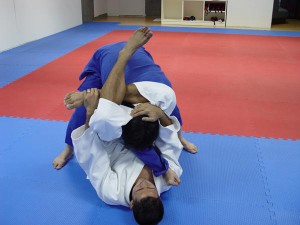
BJJ Submission
Strategy number 2: Bottom Guard Player. As most people well acquainted with BJJ or MMA know, being on the bottom does not necessarily mean one is losing the match or fight. Many submissions or sweeps are possible from bottom guard which can lead to victory. Some instructors would recommend that a grappler not pull guard initially and try to go to the takedown, resorting only to the “bottom guard strategy” if taken down. This is often a good philosophy, though I would argue that guard pulling does have a time and place perhaps if one’s opponent is an amazing wrester who he simply cannot take down but whom he thinks he can easily submit from guard. Regardless, use of an aggressive bottom guard can be a way to achieve 1st place in a tournament and I used this strategy back in 2007 to submit a much larger opponent in the finals of the No-Gi absolute division at Brad Daddis’s South Jersey Grappling Championships. After submitting my first two opponents I found myself up against a wrestler who was much larger than me, probably around 230lbs while I myself was only about 170lbs. He quickly took me down with a double leg which I felt powerless to stop. Once on my back in bottom guard however I waited for him to attempt a double-unders guard pass at which point I transitioned to a triangle choke. Being such a large guy he lost his footing while leaning forward to stack me up and toppled forward allowing me to land in a mounted triangle position. From there I turned and secured the triangle choke while on my side to take home the belt for the absolute division.
Strategy number 3: Stop, Drop and Leglock or Go for the Sub from Standing
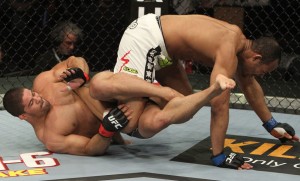
Rousimar Palhares often uses the Stop, Drop, and Leglock Strategy
“Stop, Drop and Leglock” is a term that I coined for a strategy which I have been extremely successful with in tournaments, though I by no means created it. Professional fighters like Masakatsu Imanari and Rousimar Palhares have made this strategy work for them in many high level fights, proving it is not only effective in sub grappling. When it comes to the standup portion of a Brazilian Jiu-Jitsu or Submission Grappling match, most grapplers think that there are really only two options: either go for the takedown or pull guard or half guard. There is, however, a 3rd option, which is to go for the submission from the feet. While most subs will be completed on the ground, many can be attempted from the feet and this very frequently catches the opponent off guard because he does not consider it an option or something he needs to be concerned about. I myself am not particularly good at flying armbars, flying triangles, standing guillotines or standing Kimura-traps, but these are also very effective submissions which can be pulled off from a standing position in either Gi Jiu-Jitsu or no-gi submission grappling. For me, going for leglocks from a standing position has always been very natural and effective. The way that I typically do it is by starting off the match with a little bit of hand fighting and making it look as though I am going to try for a takedown. Once I get close enough and am convinced that the opponent is distracted, I then like to drop to my back, hook the opponents ankle with my arm and spin upside down, wrapping my other leg around my opponent’s straightened leg while he is still standing. From there he will inevitably fall one way or another because I will be pulling his base out from under him. Then I usually transition to any number of leg locks like toeholds, heel hooks or straight kneelocks. If these do not work however, I have found that upper body submissions like triangles or armbars can sometimes be transitioned to or the leg lock can be used as a sweep by letting go and sitting up on top of the opponent. This strategy isn’t only effective because it is unpredictable but also because it forgoes all the other usual positions. If done correctly you don’t have to worry about passing your opponents guard or preventing him from passing yours. Instead, you cut right to the chase and start the submission battle right away. Even better, this strategy often ends the match very quickly, leaving one with extra energy in a tournament for one’s next matches. I used this several years ago to take first place at a no-gi division at the Diamond State Games in Delaware, when I dropped down quickly and secured a tap by way of toehold against a professional Pure MMA fighter.
Strategy number 4: Submission Over Position
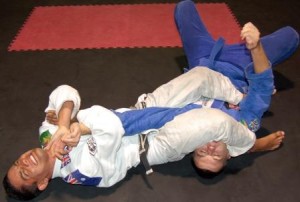
The armbar is a common BJJ submission
In a way, this strategy goes hand in hand with strategy number 3 because when going for a sub from standing you are not generally starting off with a concern over gaining dominant ground position and once you hit the ground you start a submission chain which very frequently leads to the match ending before any static or conventional position is achieved. However, this strategy differs of course in that you can start the match off with a conventional takedown, sweep or guard pull and still take this attitude into the match as it progresses. The general idea here is not being overly concerned with guard passing, achieving or maintaining side mount, mount or back mount, or even being overly concerned with whether or not your opponent passes your guard or gets a dominant top position on you. This is a very “all or nothing” approach as if it fails one usually ends up down on points, but it’s a very pro-active and aggressive way of grappling. I used this strategy to win the opening round of the NAGA Worlds in 2010 in the No-Gi Advanced Welterweight division against Michael Padilla, a well known professional grappler and Amateur MMA fighter. The match started with him shooting a single, which I sprawled on, at which point he off balanced and swept me to bottom half guard. After ending up in full guard he lifted me up off the ground at which point I hooked one his legs and used my typical upside-down leg attack. While trying to secure the leg lock I placed no concern over what position we would end up in if the leg lock failed. I initially tried a toehold and then a straight knee lock, both of which he defended. However, in his haste to employ strategy number 1 and end up in top control and feeling secure in having shut off my lower body attacks he forgot to be wary of upper body submissions and as he tried to sit up in my full guard I switched my hips and sunk in a triangle for the tap, putting me in the finals of that division.
Strategy number 5: Hold Onto That Point
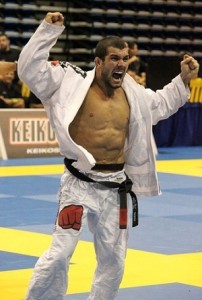 This strategy is seen in many tournaments these days where two evenly matched opponents cannot submit eachother or score large numbers of points so one becomes satisfied with gaining a one point advantage and preventing himself from being scored on to take the win. After winning that first match by triangle in the opening round of the Advanced No-Gi Welterweight division at the NAGA Worlds in 2010, I found myself in the finals against a very skilled 10th Planet Jiu-Jitsu Purple Belt and this was the strategy that I used. At the beginning of the match he pulled guard and I went for a heel hook. NAGA awards points for strong submission attempts so I was given one point for this. Following this, not much happened in this match. He spent some time in my guard trying to pass which he could not do, but neither could I secure a sub or a sweep. Eventually, we found ourselves back on our feet and not being a wrestler he was wary to go for a takedown on me. I was also wary to go for one on him because I thought it might leave me open to a guillotine attempt, and being up by one point I knew the onus was on him to score. As the match winded down he shot for a double leg takedown which I sprawled on. I then pulled guard and controlled him for the remaining seconds to win the division and take home the belt. It was a conservative win, but it worked, and though less than exciting to watch this strategy consistently works for many top grapplers when all else fails.
This strategy is seen in many tournaments these days where two evenly matched opponents cannot submit eachother or score large numbers of points so one becomes satisfied with gaining a one point advantage and preventing himself from being scored on to take the win. After winning that first match by triangle in the opening round of the Advanced No-Gi Welterweight division at the NAGA Worlds in 2010, I found myself in the finals against a very skilled 10th Planet Jiu-Jitsu Purple Belt and this was the strategy that I used. At the beginning of the match he pulled guard and I went for a heel hook. NAGA awards points for strong submission attempts so I was given one point for this. Following this, not much happened in this match. He spent some time in my guard trying to pass which he could not do, but neither could I secure a sub or a sweep. Eventually, we found ourselves back on our feet and not being a wrestler he was wary to go for a takedown on me. I was also wary to go for one on him because I thought it might leave me open to a guillotine attempt, and being up by one point I knew the onus was on him to score. As the match winded down he shot for a double leg takedown which I sprawled on. I then pulled guard and controlled him for the remaining seconds to win the division and take home the belt. It was a conservative win, but it worked, and though less than exciting to watch this strategy consistently works for many top grapplers when all else fails.
These 5 strategies are battle tested and all equally capable of leading a grappler to a win under any tournament format. It is important to know how to use each one as opponents’ styles will vary and one method alone will not always lead to victory. Next time you have an upcoming grappling tournament consider which of these you may want to use and be prepared to use each if your primary strategy does not work out the way you had planned.
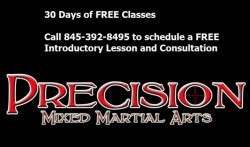
Poughkeepsie BJJ
Train with Jamey at Precision Mixed Martial Arts in Lagrangeville, NY and get the best Poughkeepsie BJJ training available. Classes 7 days a week. Call us at 845-392-8495 or click here to learn more. Make sure to ask about our 30 Day FREE Trial.
Quantum Mechanics – The Jiu-jitsu of Ryan Hall and fifty/fifty BJJ
If you train at Precision MMA then you know how much hard work Chris Stanley does to keep things running smoothly. So for his birthday I wanted to show him how much I appreciated all he’s done for the gym and take him to Virginia to train with his favorite grappler Ryan Hall. Ryan was gracious enough to make time in his very busy schedule to welcome us and teach a private to Stan.
I love traveling to different gyms. I get to experience a different training culture, techniques, philosophies and strategies and use them to enhance my game as well as my students’.
When we arrived at 50/50 we first took part in Seph Smith’s competition class. The class is tailored specifically for seasoned BJJers. A series of movement drills and dynamic running warmed up the class before getting into technique. The techniques were a series of 5 moves in what I term the “call and response” method. One partner mounts, the other escapes and sweeps – each partner has an active roll in the drilling sequence which helps keep students from zoning during their repetitions. Seph would make his rounds pointing out the finer points of the techniques and reminding students of the competitive aspect of the class. Techniques were to be executed immediately without hesitation, the second you were mounted you were to shrimp, delay would be the beginning of the end from a competition stand point.
The live rounds began working specifically from the mount or guard to reinforce the previous techniques taught. Short in duration, but high in intensity students were encouraged to take the bull by the horns and make things happen rather than grappling lackadaisically. The biggest difference I noticed rolling with the students at 50/50 vs my home gym was the approach from the guard. 50/50 students welcomed the open guard, alternating between butterfly and various forms of De La Riva predominantly as opposed to the tight closed or high guard I typically encounter.
Following the class Stan and I took a private lesson with Seph. I’ve watched Seph for years on the competition scene and the thing that always stood out about his game was his lethal leg lock game. Leg attacks are far from my strong point so I was very excited to add some new wrinkles to that aspect of my game. Unlike the way many teach leg attacks, Seph emphasized the enteries and counter attacks as much as the submission finishes. I was especially happy that he worked his attacks off the leg drag and knee slice passes since those are two of my favorite passing methods. Seph showed us his unique way of trapping the foot in the heel hook position. I would elaborate, but I was sworn to secrecy. What I can tell you is the details were 100% “game changers” for me. We also went over strategies from the 50/50 position, which as the gym’s namesake would indicate, were pretty incredible. Seph then peeled back the curtain on his strategy, pass to leg lock, leg lock to pass. The ebb and flow of his transitions smoothly relied on the old adage of the finding the path of least resistance.
The following day Stan and I made it to 50/50 early so we could rep everything we had learned from Seph. While drilling I saw Ryan working his boxing in the corner of the gym and was surprised how comfortable he looked on his feet. I have no doubt his striking will surprise whoever has the misfortune of fighting him next. Once I finished drilling I saw a few blue belts practicing the 2 on 1 Russian, one of my favorite positions. I gave a few pointers and then we had an awesome rolling session.
Ryan finished up boxing and joined Stan and I in the corner of the gym. He wanted to get a feel for Stan’s game so he first watched the two of us roll so he could evaluate his game. Ryan then got on the mat with Stan himself for further investigation. After a few minutes Ryan reported his findings. Ryan’s outlook on jiu-jitsu was very unique. He focused his attention on the “big picture”. He wasn’t so concerned with the precise grip Stan was using, but rather the structural integrity of his overall positioning. Ryan told us that when using the guard his goal was to always keep his lines of defense tight. Knees and elbows connected with an engaged core and advantageous angle. The particular moves were less important since they could only be executed from proper positioning. He then broke down the instances where Stan was extended, flat, or disconnected. Conversely, Ryan explained that guard passing was simply finding the hole in the structure and occupying that space.
Ryan’s approach to grappling wasn’t concerned with particular techniques, but rather with physics. Rather than discussing underhooks and grips he spoke of levers, wedges and points of leverage. At times listening to him speak evoked memories not of jiu-jitsu class, but of science lectures on simple and complex machines. Ryan’s approach has no limitations. There is no dogma or prejudice in Ryan’s approach, it was simply problem solving. Techniques were evaluated with a scientific method – arrive at the proper conclusion and duplicate the results under varying circumstances.
The two privates we took were invaluable. With Seph we walked away with a solid sequence of techniques we could practice and begin implementing, while with Ryan we were provided a framework we could use to approach all of our existing techniques.
If you happen to be fortunate enough to live in the Virginia area check out 50/50 HERE
Otherwise, you can still check out Ryan’s incredible instructional videos HERE

